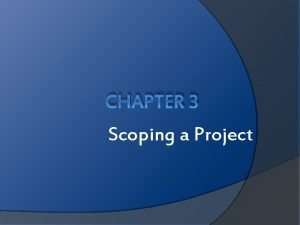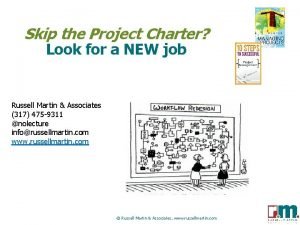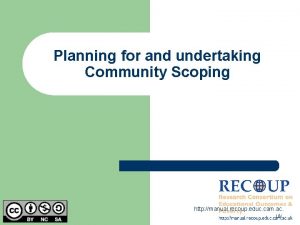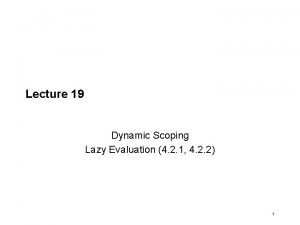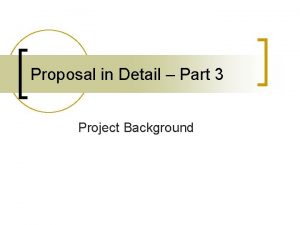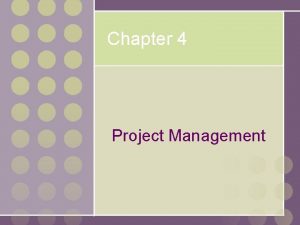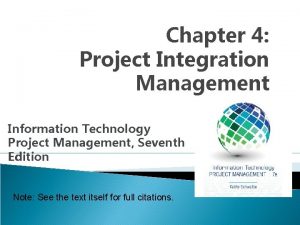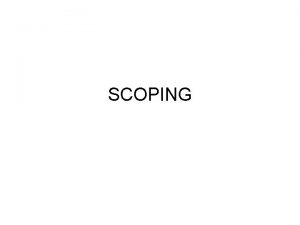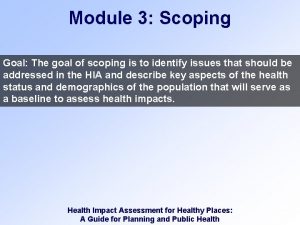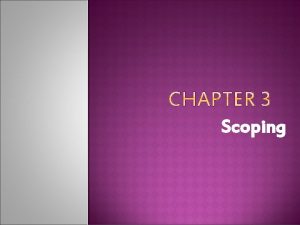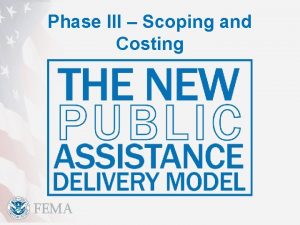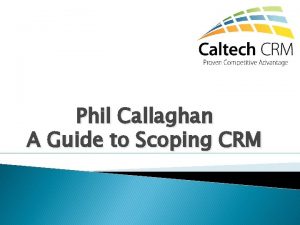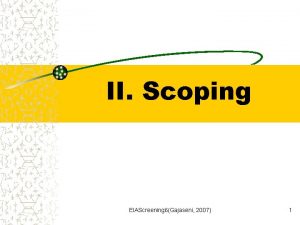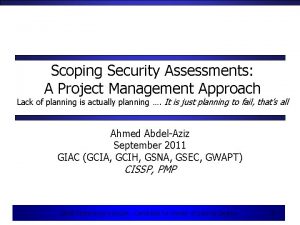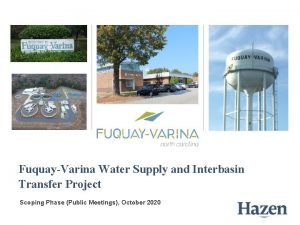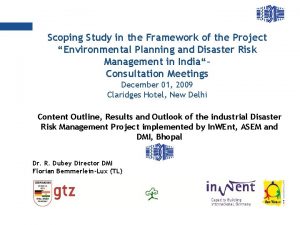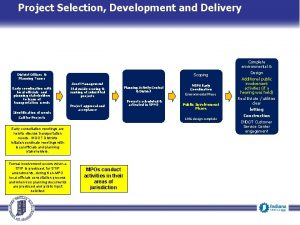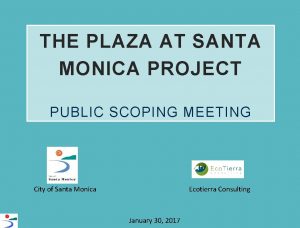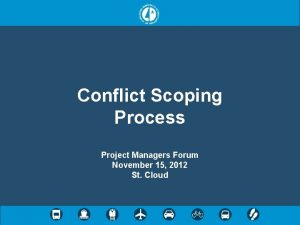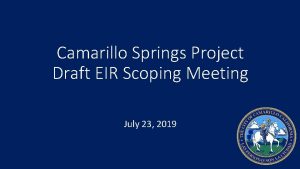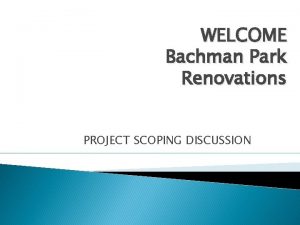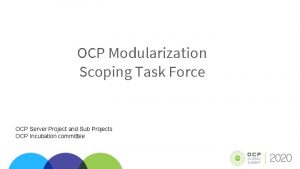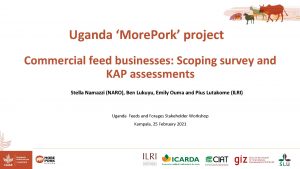CHAPTER 3 Scoping a Project Scoping a project






















- Slides: 22

CHAPTER 3 Scoping a Project

Scoping a project Scoping • § phase where developer trying to understand the breadth and depth of the project so can begin to estimate time and costs § it is very important to have a clear agreed definition of what clients. Any changes that affect the scope of the project can be re-cost § Those facts important for developer to define the cost and quality level within time

Initial phase of the project (scoping) It is very important to make sure client and developer have a clear brief of the project in term of: Time for development Expected use of media Result needed Several approaches used to define the initial brief: Creative side of m/m development – creative director & an account manager Software dev. Process – technical director & project manager Content driven – information strategist/

Initial phase of the project. . Examples of phases used : Specify, build, test, deliver Discover, design, build, deploy relate, define, develop, test, Initiate, scope, produce, test, deliver Good practice for companies to spend time producing clear, flexible guidelines and checklist for stages

Initial phase of the project. . Extended scoping analysis techniques: Concept System (CUI) ○ To brainstorm, organize, rank, sort, cluster, prioritize and action plan ○ Quite difficult General purpose scoping questionnaire ○ As a checklist ○ Either for online or offline project

Online interactive media scoping questionnaire Questions to ask clients: Previous multimedia experience Statement of what the client wants Type of project Internet/intranet/extranet Hybrid web/CD Mobile Market sector of the client Project bias Importance ranking Size of section Browser/platform expectations Site maintenance

Online interactive media scoping questionnaire. . Benefits/achievements wanted Access and use Emotional reactions considerations Media mix Content Time for development Special considerations Budget

q. Client’s previous multimedia experience § Client may have good and bad experiences. § Learn what they like and don’t like in terms of ways of working as well as in interactivity. § Need to cover both on- and offline experience, whatever sort of project you are working. q. Statement of what the client wants § Client’s initial statement of what they want § It helps to formulate what the client says they want at the beginning of the interview. § The more vague they are the harder you will have to work to get a good specification.

q. Type of project § The delivery medium affects the specific type of project that will be produced. §Internet/intranet/extranet §Hybrid web/CD § Mobile q. Market sector of the client §The major categories of commercial, corporate, government and education are included as an indicator of your potential administrative overhead. § As a rule, small commercial sites allow you

q. Project bias §The bias on the type of data will help to determine the type of interactivity needed, which will in turn have an effect on the programming and design. q Importance ranking § need to recognize priorities of amount and type of information. §An alternative way of approaching this quick form of ranking with clients is called Mo. SCow. §This gets the client to define what they must have (M), should have (S), could have (C) and want (W).

q Size of section § The amount of information you are given to structure for the site affects the time needed to complete the project and therefore the cost. §Although it is all relative, you have to try and understand the amount of material within each section to get a feel of how to apportion time and resources as well as cost. q Browser/platform expectations § This is the section where you are trying to understand how much extra programming will be involved to make the application work for particular browsers and their various versions and whether the application needs to work cross -platform or multi-platform.

q Site maintenance §It is important to raise site maintenance early in the discussion. §If the client is going to update the content, you have to know the competence level of those who will be involved so that you can design templates accordingly. q Benefits/achievements wanted §It is not easy to define objectives for the company or for the users, but if the client does not attempt this, the specification will lack direction, and will tend to meander.

q Access and use §This section will give you more detail about the content in relation to the user. §The type of user influences the structure and the level of interactivity. q. Emotional reaction considerations §There is certainly a drive to make online experiences focused and productive as usability issues are taken into account. This has been needed.

q Media mix §The client may have a vague conception of their site in terms of the media they expect to see as part of it. §It is good to get these expectations out in the open, as you may well already have an indication of which media to use based on the emerging understanding of the audience q Content (existing assets) and content. §The cost of development in any interactive medium is affected by the number and type of suitable assets that the client already has, as long as their specification will retain enough quality for reuse in a new way.

q. Time for development §There is often a mismatch between clients’ and developers’ expectations of the development time that is needed for a project. §Client do not usually appreciate the complexity of some of the processes involved. § Their expectations may be impossible to achieve, and the scope of a project may have to be reduced to meet a definite timescale. q Special considerations §Online database, testing and localization issues can be complex. § These extra questionnaires are as much a resource for you to raise the awareness of the client as to exactly what is involved in these processes as to help you determine the true scope of the project.

q Budget §In an ideal world (for the developer), projects would be scoped and specified and clients would then pay for work done on a time and materials basis. §Unfortunately, clients will usually want a fixed price agreed up front, and will not want to change that even if circumstances change.

Offline interactive media scoping questionnaire The offline project is ‘fixed in stone’ when it is complete. So the clients and developer has to be absolutely sure about the project. Questions to ask clients: Previous interactive media experience Statement of what the client wants Type of project Commercial/corporate/government Presentation/POI/Training etc Content Audience Est. number of users Estimated number of systems

Offline interactive media scoping questionnaire. . Location Benefits/achievements wanted Content (existing assets) Time for development Platform Emotional reaction considerations Media mix Special considerations Testing strategy Budget

Offline projects categories Multimedia presentation Shorter time – 20 to 30 minutes Must understand the exact uses of end-product Training Commercial or corporate Emphasis on defining the expected changes in the user’s behaviour after using application Might need data collection for evaluation POI kiosks Give information about exhibits such as tourist information systems to applications in museums Normally link to internet Consider hardware configuration

Offline projects categories. . Publishing Example as support materials Games based on successful book characters Education Edutainment Entertainment Games, quizzes, about celebrities Reference Using interactive search facilities to locate specific information International project

Post-meeting responsibilities Can decide if the definition of the project is going to be straightforward or not May need a couple more meetings to put forward a clear proposal Once the scoping questionnaire is complete, make a copy and send to client as a record If need major changes than project has to be rescoped at the client’s expenses

If possible establish the client’s expectations and needs for the project in detail, the assets they can bring to the project, the audience profile, and the budget. If the definition is not going to be straightforward, offer a paid pre-project stage to help them define their requirements. Record the meeting clearly to form the basis of the proposal. Assess whether the brief is realistic in terms of development time, the use of media, and the client’s expected outcomes. Give clear requests for further information from the client within a timeframe.
 Project scoping exercise
Project scoping exercise Skip this
Skip this How do you undertake community scoping
How do you undertake community scoping Problem scoping
Problem scoping Dynamic scoping
Dynamic scoping The role of project management in achieving project success
The role of project management in achieving project success How to write a project background
How to write a project background Iteration workflows in software project management
Iteration workflows in software project management Reducing project duration
Reducing project duration Modern project management began with what project
Modern project management began with what project What is strategic assessment in software project management
What is strategic assessment in software project management Traditional project management vs modern project management
Traditional project management vs modern project management Types of project audit in project management
Types of project audit in project management Integrating metrics within the software process
Integrating metrics within the software process Ms project agile template
Ms project agile template Methodology sample for project
Methodology sample for project Project termination
Project termination Science investigatory project sample
Science investigatory project sample Chapter 3 project management
Chapter 3 project management Chapter 1 modern project management
Chapter 1 modern project management Information technology project management 9th edition
Information technology project management 9th edition Project management chapter 4
Project management chapter 4 Directing and managing project execution
Directing and managing project execution
